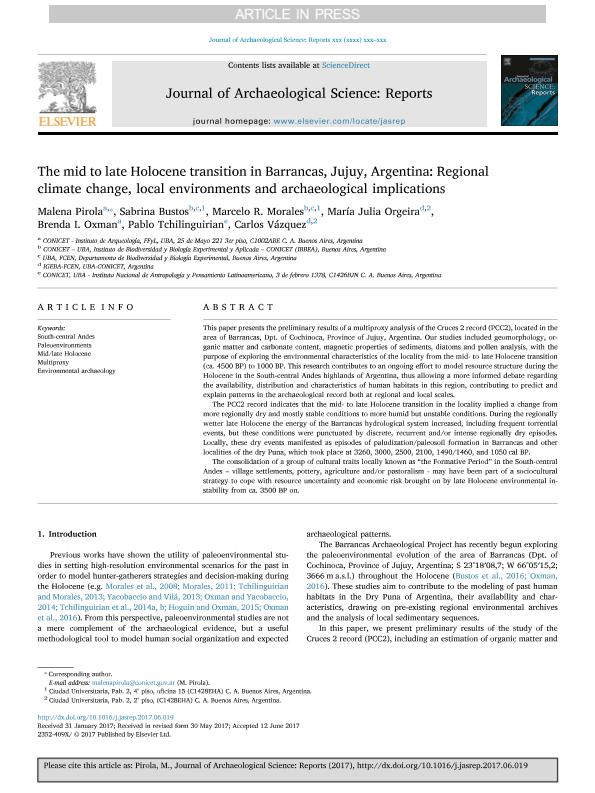Artículo
The mid to late Holocene transition in Barrancas, Jujuy, Argentina: Regional climate change, local environments and archaeological implications
Pirola, Malena ; Bustos, Sabrina
; Bustos, Sabrina ; Morales, Marcelo Raul
; Morales, Marcelo Raul ; Orgeira, Maria Julia
; Orgeira, Maria Julia ; Oxman, Brenda
; Oxman, Brenda ; Tchilinguirian, Pablo
; Tchilinguirian, Pablo ; Vázquez, Carlos
; Vázquez, Carlos
 ; Bustos, Sabrina
; Bustos, Sabrina ; Morales, Marcelo Raul
; Morales, Marcelo Raul ; Orgeira, Maria Julia
; Orgeira, Maria Julia ; Oxman, Brenda
; Oxman, Brenda ; Tchilinguirian, Pablo
; Tchilinguirian, Pablo ; Vázquez, Carlos
; Vázquez, Carlos
Fecha de publicación:
06/2017
Editorial:
Elsevier
Revista:
Journal of Archaeological Science: Reports
ISSN:
2352-409X
Idioma:
Inglés
Tipo de recurso:
Artículo publicado
Clasificación temática:
Resumen
This paper presents the preliminary results of a multiproxy analysis of the Cruces 2 record (PCC2), located in the area of Barrancas, Dpt. of Cochinoca, Province of Jujuy, Argentina. Our studies included geomorphology, organic matter and carbonate content, magnetic properties of sediments, diatoms and pollen analysis, with the purpose of exploring the environmental characteristics of the locality from the mid- to late Holocene transition (ca. 4500 BP) to 1000 BP. This research contributes to an ongoing effort to model resource structure during the Holocene in the South-central Andes highlands of Argentina, thus allowing a more informed debate regarding the availability, distribution and characteristics of human habitats in this region, contributing to predict and explain patterns in the archaeological record both at regional and local scales. The PCC2 record indicates that the mid- to late Holocene transition in the locality implied a change from more regionally dry and mostly stable conditions to more humid but unstable conditions. During the regionally wetter late Holocene the energy of the Barrancas hydrological system increased, including frequent torrential events, but these conditions were punctuated by discrete, recurrent and/or intense regionally dry episodes. Locally, these dry events manifested as episodes of paludization/paleosoil formation in Barrancas and other localities of the dry Puna, which took place at 3260, 3000, 2500, 2100, 1490/1460, and 1050 cal BP. The consolidation of a group of cultural traits locally known as “the Formative Period” in the South-central Andes – village settlements, pottery, agriculture and/or pastoralism - may have been part of a sociocultural strategy to cope with resource uncertainty and economic risk brought on by late Holocene environmental instability from ca. 3500 BP on.
Archivos asociados
Licencia
Identificadores
Colecciones
Articulos(IBBEA)
Articulos de INSTITUTO DE BIODIVERSIDAD Y BIOLOGIA EXPERIMENTAL Y APLICADA
Articulos de INSTITUTO DE BIODIVERSIDAD Y BIOLOGIA EXPERIMENTAL Y APLICADA
Articulos(IGEBA)
Articulos de INSTITUTO DE GEOCIENCIAS BASICAS, APLICADAS Y AMBIENTALES DE BS. AS
Articulos de INSTITUTO DE GEOCIENCIAS BASICAS, APLICADAS Y AMBIENTALES DE BS. AS
Articulos(SEDE CENTRAL)
Articulos de SEDE CENTRAL
Articulos de SEDE CENTRAL
Citación
Pirola, Malena; Bustos, Sabrina; Morales, Marcelo Raul; Orgeira, Maria Julia; Oxman, Brenda; et al.; The mid to late Holocene transition in Barrancas, Jujuy, Argentina: Regional climate change, local environments and archaeological implications; Elsevier; Journal of Archaeological Science: Reports; 6-2017; 1-17
Compartir
Altmétricas



